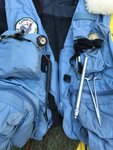Coming off of the warmest weekend of the year so far, we long for the cooler days we experienced during the beautiful month of June!
Our rivers and streams are holding fairly steady at slightly …
This item is available in full to subscribers.
Please log in to continue |


Coming off of the warmest weekend of the year so far, we long for the cooler days we experienced during the beautiful month of June!
Our rivers and streams are holding fairly steady at slightly above average flows thanks to the previous week's rains -- the Beaverkill at Cooks Falls has registered just above the average flow all week, and at midday on Sunday, July 19, that figure was 171 cubic feet per second; above the average for that date of 145 cfs over the past 106 years of record-keeping.
However, the warmer weather has caused water temperatures to be higher than we like to see - ranging from a low of 67 to a high of about 77 degrees Fahrenheit over the weekend, no doubt Sunday afternoon's and Monday's continued 90-degree heatwave will have raised water temperatures even higher.
Here in the Catskills the most common species of trout are brook, brown and rainbow trout. Their requirements for water purity, oxygenation and cold temperatures are the highest; of the three, brook trout are the least tolerant of warm water conditions. Trout are cold-blooded, which means that their body temperature adjusts to match the temperature of the water in which they are living. As such, water temperatures directly affect their growth, reproduction and survival.
And so, it is important to be aware of water temperatures if you fish for trout during the heat of summer. Waters that are up in the high 70s are considered thermally stressful for trout, and they will seek out cooler waters found at tributary mouths or in underground spring seepages in order to survive. These fish should never be disturbed, as they are vulnerable and are already in a stressed condition. Even fish that are properly handled and released during periods of high water temperatures will be so exhausted that they may not survive.
Some may wonder why, and think incorrectly that it's OK to fish in warm water as long as they handle the fish as little as possible and release it quickly after being caught; however the trout are already in a state of stress and will become so exhausted that they may not survive despite the misguided angler's best intents. This is due to the fact that warmer water contains less oxygen (measured as dissolved oxygen) than colder water; as water temperatures rise, the level of dissolved oxygen in the water decreases. And although trout can survive high temperatures for short periods of time, it is only with the provision that the water is well saturated with oxygen. As the oxygen level of the water falls, temperature tolerance of the trout also decreases.
The size of the fish as well as the species (such as brook, brown and rainbow trout) will also have an effect on survival in times of high water temperatures and low flows of summer. Smaller trout, such as young-of-the-year fingerlings, will have a better chance of survival in very warm water than adult fish. Rainbow trout can tolerate slightly higher water temperatures than browns, whose lethal limit is in turn a few degrees higher than that of brook trout.
During midsummer, temperatures do not rise as much on rainy or overcast days in comparison to clear, sunny days, when water temperatures can spike as much as 15 degrees or more during daylight hours. Hot, humid weather with no cooling at night drives water temperatures high. Generally, the warmest time of the day is at 4 p.m. By 7 p.m. the temperature usually drops a degree or two and continues dropping until sunrise, which is about when water temperatures are lowest. As mentioned previously, during the heat of summer, the best times for fishing are early morning and late evening after the sun has gone down and there is a bit of coolness in the air.
When water temperatures rise above 66 degrees Fahrenheit, it's a good idea to carry along a thermometer with which to record the water temperature when fishing during the heat of summer; as fishing success can be determined by only a few degrees either way. Once temperatures reach into the 70s, remember that the trout may disperse to find cooler respite areas - and all those special places you remember having successful fishing in early spring may be devoid of trout in midsummer's heat.
Fortunately, we have the tailwater fisheries to take advantage of when temperatures soar - those rivers impounded by reservoirs whose bottom releases provide much-welcomed cold water in summertime. The lower Neversink, East and West Branches of the Delaware can provide trout fishers a cool retreat, and the anticipation of a good fishing experience when the summer sun warms our free-flowing rivers and streams.
Judy Van Put is a long-time member of the NYS Outdoor Writers Association, and is the recipient of the New York State Council of Trout Unlimited's Professional Communications Award.
Comments
No comments on this item Please log in to comment by clicking here